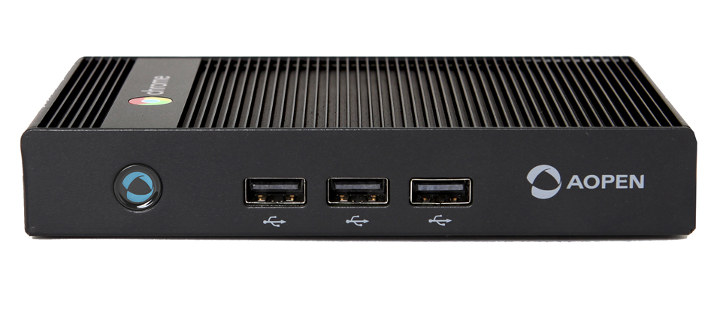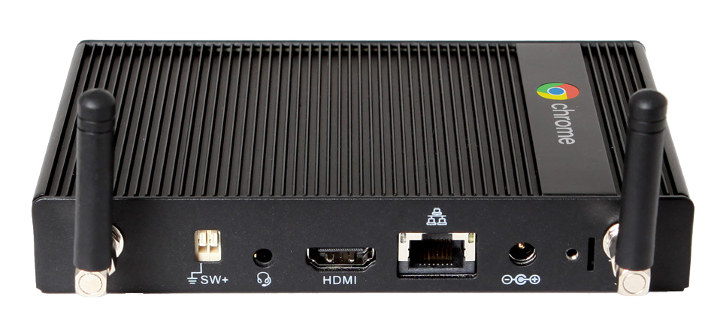Most ChromeOS devices are designed for either the consumer or educational markets, but Google’s operating system can also be used for commercial applications such as digital signage.
A cheap way to set up a ChromeOS based digital is to get a ChromeBit (around $100 used) and install one of the Digital Signage apps for the OS. But as I checked out Linux 5.4 changelog, I came across AOPEN Chromebox Mini (codename Fievel) powered by a Rockchip RK3288 processor and described as an “enterprise-ready” Chromebox for 24/7 operation as digital signage or kiosk.
 AOPEN Chromebox Mini specifications:
AOPEN Chromebox Mini specifications:
- SoC – Rockchip RK3288C quad-core Cortex-A17 processor @ up to 1.8GHz with Arm Mali-T764MP GPU clocked at up to 600 MHz
- System Memory – Dual-channel 4GB LPDDR3
- Storage – 16GB eMMC 5.0 flash
- Video Output – HDMI up to 1080p60
- Audio – 1x combo jack with Line out/Line in
- Connectivity – Gigabit Ethernet, WiFi 802.11 b/g/n/ac + BT4.0
- USB – 3x USB 2.0 ports with support for BC1.2 charging
- Misc – Power button with LED, external power switch header (SW+)
- Power Supply – 15~50V DC via a power jack; DC jack holder screw hole (right of DC jack in the photo below); support for AC Power Auto Recovery (APAR)
- Dimension – 146 x 93 x 24 mm
- Weight – 403g
- MTBF – 50,000 hrs
- Temperature Range – Operating: 0ºC ~ 40ºC; storage: -20ºC ~ 60ºC
- Relative Humidity – 90% (50ºC non-Condensing)
 This looks like hardware that was released two years ago, and indeed AOPEN Chromebox Mini was announced in 2017, it just took two years before some code was submitted to the mainline Linux kernel.
This looks like hardware that was released two years ago, and indeed AOPEN Chromebox Mini was announced in 2017, it just took two years before some code was submitted to the mainline Linux kernel.
It’s sold on Amazon for around $260, and there are mixed reviews mostly from people bought it as a mini PC, si as the processor is quite slow for a typical end-user, but this should not be an issue for digital signage.
More details may be found on the product page. If you’d prefer something a bit more recent and powerful, the company introduced Chromebox Commercial 2 with a similar form factor, support for dual 4K output, and a choice of Intel Celeron 3865U or Core i3-8130u processor for respectively $363 and $683.

Jean-Luc started CNX Software in 2010 as a part-time endeavor, before quitting his job as a software engineering manager, and starting to write daily news, and reviews full time later in 2011.
Support CNX Software! Donate via cryptocurrencies, become a Patron on Patreon, or purchase goods on Amazon or Aliexpress





Ah, *this* is an example of a properly designed form factor. Having the jack on the front would have been even better, but it’s already quite good as-is. The RK3288 was an excellent and quite powerful chip. It’s a bit dated by now, but seeing that people use their RPi in armv7 mode makes me think this shouldn’t be a problem at all. And in 32 bits, the A17 and A72 deliver roughly comparable performance. Not sure that many people will want to put $260 into an ARM box when you can find x86 devices in the same price range, that reassure them on the device’s reusability though.
but can it boot up and run in Kiosk mode?
Fyi you can transform any rk3288 into a Chromebox with some fiddling onto e.g. MQmaker MiQi and i guess Tinkerboard too